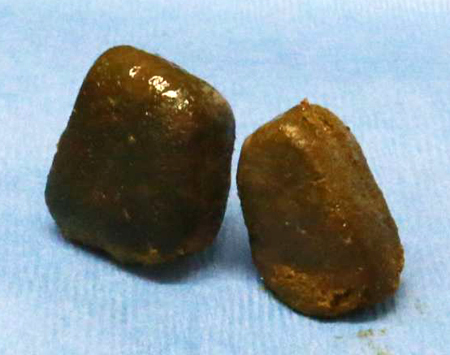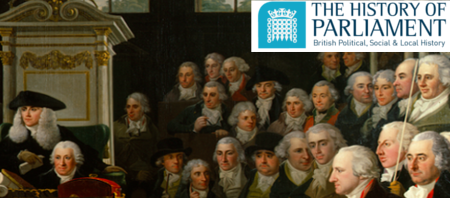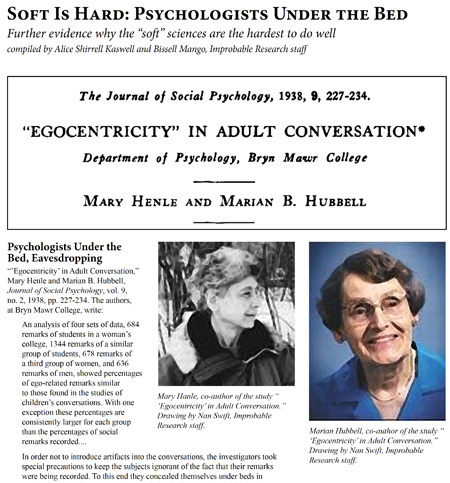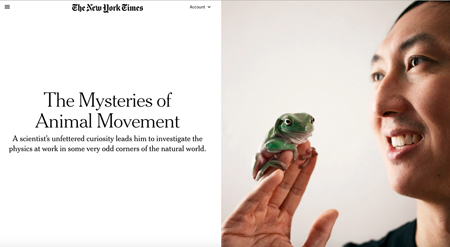Marc Abrahams's Blog, page 166
November 18, 2018
A better-rounded understanding of why wombat poo is cubic
Ian Sample reports, in The Guardian, a new discovery by Ig Nobel Prize winners, about wombat poo shape:
Scientists unravel secret of cube-shaped wombat faeces
Researchers investigate why excrement emerges in awkward-shaped blocks
… “My curiosity got triggered when I realised that cubical feces exist,” said Patricia Yang pictured below], a postdoctoral fellow in mechanical engineering at Georgia Institute of Technology in Atlanta. “I thought it was not true in the first place.”
In a new study, Yang and her colleagues have had a fresh crack at the problem. To gain new insights into the mystery, they studied the digestive tracts of common wombats that had been put to sleep after being struck by cars and trucks on roads in Tasmania.
Close inspection revealed that the wombat’s excrement solidified in the last 8% of the intestine, where the faeces built up as blocks the size of long and chunky sugar cubes. By emptying the intestines and inflating them with long modelling balloons, of the sort used to make balloon animals at children’s parties, the researchers measured how the tissue stretched in different places….
The first public presentation happened today, at the annual meeting of the American Physical Society.
The 2015 Ig Nobel Prize for physics was awarded to Patricia Yang, David Hu, and Jonathan Pham, Jerome Choo, for testing the biological principle that nearly all mammals empty their bladders in about 21 seconds (plus or minus 13 seconds).
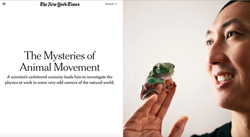 The urine-duration research is documented in the study “Duration of Urination Does Not Change With Body Size,” Patricia J. Yang, Jonathan Pham, Jerome Choo, and David L. Hu, Proceedings of the National Academy of Sciences, vol. 111 no. 33, August 19, 2014, pp. 11932–11937.
The urine-duration research is documented in the study “Duration of Urination Does Not Change With Body Size,” Patricia J. Yang, Jonathan Pham, Jerome Choo, and David L. Hu, Proceedings of the National Academy of Sciences, vol. 111 no. 33, August 19, 2014, pp. 11932–11937.
David Hu, and some of the research done by him Patricia Yang and their colleagues, was profiled a few days ago in the New York Times.

November 16, 2018
The Kidney Stone of Alderman Adams
The History of Parliament blog detects a connection between Ig Nobel Prize-winning roller-coaster/kidney stone research and, yes, the history of Britain’s parliament:
The Kidney Stone of Alderman Adams
The link between the Ig Nobel Prize for improbable research and the 1640-1660 Section of the History of Parliament Trust is not immediately obvious; but the Ig Nobel for medicine which was awarded at the ceremony at Harvard University on 13 September this year has very distinct seventeenth century resonances. The laureates, Marc Mitchell and David Wartinger, had followed up anecdotal reports that violent movement, especially associated with funfairs, could cause kidney stones to dislodge and pass through the renal system into the bladder and out of the body, by conducting proper scientific field trials, using a simulated renal system and real ‘calculi’ or kidney stones….
To modern eyes, Alderman Thomas Adams is one of the more appealing of mid-seventeenth century politicians…. Adams enjoyed his new-found success for only a few years before his sudden death in February 1668. It is the manner of his death that provides the link with the Ig Noble Prizes and the Big Thunder Mountain Railroad, especially their concerns that such rides should be avoided by those with ‘renal calculi of a volume likely to cause ureteral obstruction’. For when Adams’s coach was involved in an accident and overturned, the violent movement dislodged a massive kidney stone which had apparently never troubled him before, but now blocked his urethra and killed him, after several weeks of ‘miserable torture’. Samuel Pepys, who had himself undergone an unpleasant and dangerous operation to remove a kidney stone a few years earlier, was later shown ‘the stone cut lately out of Sir Thomas Adams’s body’, and was suitably impressed, recording that it was ‘very large indeed, bigger I think than my fist, and weighs above 25 ounces’ [The Diary of Samuel Pepys, ed. R. Lathom and W. Matthews (1983), ix. 136].
Here’s video taken (by someone else) from the roller coaster ride that produced the Ig Nobel Prize-winning kidney stone discovery:

November 15, 2018
Justin Bieber’s opinion on the Big Bang – inconsequential, or not? (new study)
“The vast majority of scientists believe that humans have evolved over time (98%; Pew Research Center, 2015). However, recent public opinion polls indicate much more variability in the views of the general public; only 65% of Americans (Pew Research Center, 2015), 61% of Canadians (Angus Reid Public Opinion Polls, 2012), and similar amounts of British and Australians share this view.”
 A new study from Nipissing University, Ontario, Canada, has, for the first time, attempted to find out what effect ‘celebrity opinions’ might have on such viewpoints, So, when, for example, Justin Bieber [pictured] says something along the lines of :
A new study from Nipissing University, Ontario, Canada, has, for the first time, attempted to find out what effect ‘celebrity opinions’ might have on such viewpoints, So, when, for example, Justin Bieber [pictured] says something along the lines of :
“Science makes a lot of sense. Then I start thinking—wait, the ‘big bang.’ For a ‘big bang’ to create all this is more wild to think about than thinking about there being a God. Imagine putting a bunch of gold into a box, shaking up the box, and out comes a Rolex. It’s so preposterous once people start saying it.”
– what effect, if any, might it have on public acceptance of evolutionary theory? In other words :
“Are publicized celebrity opinions about human evolution merely inconsequential forms of entertainment, or do they have the potential to influence individuals’ acceptance of evolution?”
The answer, according to the research, is :
“Taken together, the results of the present set of studies provide novel evidence that exposure to a celebrity’s opinion about evolution can indeed influence individuals’ acceptance of evolution.”
See: Celebrity Opinion Influences Public Acceptance of Human Evolution published in the journal Evolutionary Psychology, September, 2018.
[ Research research by Martin Gardiner ]

November 13, 2018
The Man Who—With a Blinding, Flapping Visor—Drove on a Highway
“John’s Story – The Science of Error” is a new documentary film about John Senders, the Ig Nobel Prize winning, pioneering student of human attention and distraction. Back Lane Studios produced the film:
The 2011 Ig Nobel Prize for Public Safety was awarded to John Senders of the University of Toronto, CANADA, for conducting a series of safety experiments in which a person drives an automobile on a major highway while a visor repeatedly flaps down over his face, blinding him.
He wrote about that research: “The Attentional Demand of Automobile Driving,” John W. Senders, et al., Highway Research Record, vol. 195, 1967, pp. 15-33.
This video [which is excerpted in the new documentary] shows Senders pioneering his work:
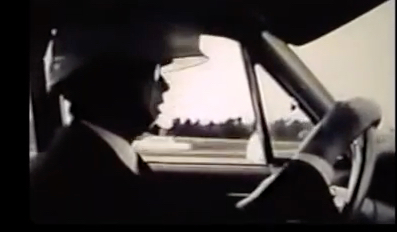

November 12, 2018
‘Occupational marks’
Occupational marks represent the effects of a repeated particular activity on a worker’s, musician’s or sportsperson’s skin. They are many and varied. They include (but are by no means limited to) :
• Surfer’s Nodules (Surfers)
• Cauliflower Ear (Boxers)
• Jazz Ballet Bottom (Dancers)
• Lichenification of the Elbows (Bank workers)
• Alopecia from Repeated Spinning on the Head (Breakdancers)
• Perioral lip dermatitis (Recorder players)
All these examples, and many more, are listed in the chapter on ‘Occupational Marks’ (pp. 137-140) in the Handbook of Occupational Dermatology. A partial preview of which is available here.
BONUS Activity : Do you have an occupational mark (not listed above)? Let us know.
Photo shows Synchronised Surfing, Manly beach, New South Wales,1938-46. Surfer’s Nodules status unknown.
Research research by Martin Gardiner

November 9, 2018
Evaluating Students’ Evaluations of Medical Professors: Are There Cookies?

Prof. Dr. med. Manuel Wenk, co-author of the cookies study. The cookies were chocolate.
Some medical schools may be selecting or rejecting faculty members because those individuals do or do not offer cookies to their students. That is a possible conclusion one might draw, after reading this new study done by faculty members:
“Availability of cookies during an academic course session affects evaluation of teaching,” Michael Hessler, Daniel M Pöpping, Hanna Hollstein, Hendrik Ohlenburg, Philip H Arnemann, Christina Massoth [pictured below], Laura M Seidel, Alexander Zarbock, and Manuel Wenk [pictured above], Medical Education, vol. 52, no. 10, October 2018, no. 1064-1072. The authors, at the University Hospital of Munster, Germany, report:
“Results from end-of-course student evaluations of teaching (SETs) are taken seriously by faculties and form part of a decision base for the recruitment of academic staff, the distribution of funds and changes to curricula. However, there is some doubt as to whether these evaluation instruments accurately measure the quality of course content, teaching and knowledge transfer.”

Dr. med. Christina Marie Massoth. co-author of the study.

November 8, 2018
Documenting Meiji Gummy Candy Flavour-Recognition Times (new study)
 If you have ever eaten a ‘Gummy Candy’ from Meiji Co., Ltd., Tokyo, Japan, in apple, grape, orange, [European] pear, pineapple, or strawberry flavours, it may have taken you a few seconds to recognise which one you were eating. If so, you are not alone. A 2018 study published in the journal Perception sought to measure ‘Distribution of Recognition Times to Fruity Flavor of Gummy Candies in Healthy Adults’. The research team found, by experiment, that on average, healthy adults took around 7.5 seconds to be able to tell which flavour they were eating.
If you have ever eaten a ‘Gummy Candy’ from Meiji Co., Ltd., Tokyo, Japan, in apple, grape, orange, [European] pear, pineapple, or strawberry flavours, it may have taken you a few seconds to recognise which one you were eating. If so, you are not alone. A 2018 study published in the journal Perception sought to measure ‘Distribution of Recognition Times to Fruity Flavor of Gummy Candies in Healthy Adults’. The research team found, by experiment, that on average, healthy adults took around 7.5 seconds to be able to tell which flavour they were eating.
Notes:
● The Ethics Committee of The University of Niigata Rehabilitation Graduate School approved the experiments
● The illustration shows the Meiji Gummy Sushi Candy, which did not feature in the study
● 22.7% of the participants got the flavour wrong
[ Research research by Martin Gardiner ]

November 7, 2018
Psychologists Under the Bed [research study]
“ ’Egocentricity’ in Adult Conversation,” is one of several studies featured in the article “Soft Is Hard: Psychologists Under the Bed — further evidence why the ‘soft’ sciences are the hardest to do well,” which is one of the articles in the special Numbers issue of the Annals of Improbable Research, which is one of the 142 issues published so far!
The psychologists-under-the-bed-eavesdropping study is by Mary Henle and Marian B. Hubbell, published in the Journal of Social Psychology, vol. 9, no. 2, 1938, pp. 227-234.

November 6, 2018
Christian Steven Hoggard joins Luxuriant Flowing Hair Club for Scientists
Christian Steven Hoggard has joined the Luxuriant Flowing Hair Club for Scientists (LFHCfS). He says:
(LFHCfS). He says:
After finishing my PhD and moving to Denmark for post-doctoral work I began to realise the amount of positive feedback on my glorious locks (no minor revisions needed here!).
Christian Steven Hoggard, PhD., LHFHCfS
Postdoctoral Researcher in Palaeolithic Archaeology and Artefact Morphometrics
Department of Archaeology and Heritage Studies | School of Culture and Society,
Aarhus University,
Højbjerg, Denmark.


November 5, 2018
Third-generation Ig Nobel Prize winner David Hu, profiled in the New York Times
David Hu’s Ig Nobel Prize-winning research, and David Hu, and David Hu’s Ig Nobel Prize-winning former advisor, and that advisor’s double-Ig Nobel Prize-winning former adviser, and lots more, are profiled in the New York Times:
…As male infants will do, his son urinated all over the front of Dr. Hu’s shirt, for a full 21 seconds. Yes, he counted off the time, because for him curiosity trumps irritation.
That was a long time for a small baby, he thought. How long did it take an adult to empty his bladder? He timed himself. Twenty-three seconds. “Wow, I thought, my son urinates like a real man already.”
He recounts all of this without a trace of embarrassment, in person and in “How to Walk on Water and Climb up Walls: Animal Movements and the Robotics of the Future,” just published, in which he describes both the silliness and profundity of his brand of research….
Dr. Hu is a mathematician in the Georgia Tech engineering department who studies animals. His seemingly oddball work has drawn both the ire of grandstanding senators and the full-throated support of at least one person in charge of awarding grants from that bastion of frivolity, the United States Army…. [He] is completely serious when he describes Dr. Hu as a scientist of “profound courage and integrity” who “goes where his curiosity leads him.”
Dr. Hu has “an uncanny ability to identify and follow through on scientific questions that are hidden in plain sight,” Dr. Stanton said.
When it comes to physics, the Army and Dr. Hu have a deep affinity. They both operate at human scale in the world outside the lab, where conditions are often wet, muddy or otherwise difficult.
In understanding how physics operates in such conditions, Dr. Stanton explained, “the vagaries of the real world really come to play in an interesting way.” …

Marc Abrahams's Blog
- Marc Abrahams's profile
- 14 followers


